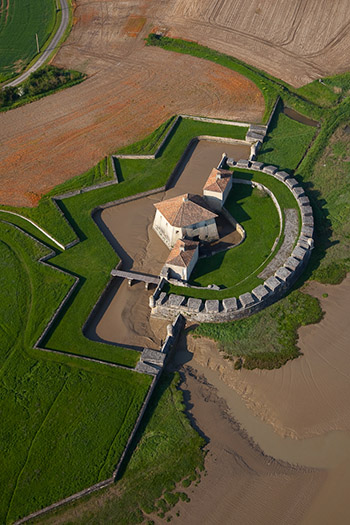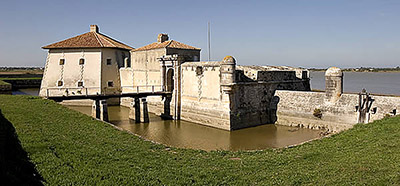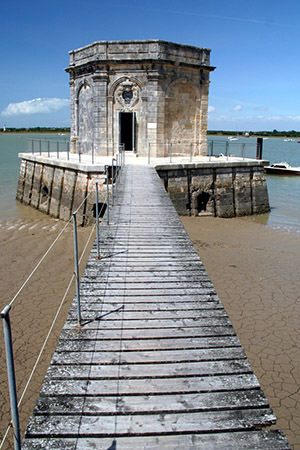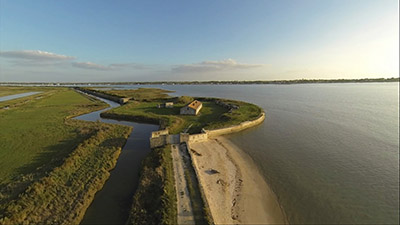 |
Fort Lupin
Rochefort, France
|
|
 |
Constructed: 1685 - 1689
Used by: France
Designed by: Vauban
Conflicts in which it participated:
None
Also known as:
Fort de la Charente
|
In December of 1665, France's Controller-General of Finances, Jean-Baptiste Colbert (1619-1683), regally pointed to the spot on France's southwest coast which would become a place of "refuge, defense and supply" for the French Navy: Rochefort.
|
 |
|
|
There already existed what would seem like a perfectly reasonable location for such a naval facility just a wee bit north along the coast, in the form of the long-established city of La Rochelle, but La Rochelle was unacceptable to the Powers That Be French.
|
 Adorable. Adorable. |
 |
Because La Rochelle was a hotbed of wicked Calvinist and Huguenot, but most importantly PROTESTANT, disagreement with the rigid religious policies of the French crown. The French Wars of Religion (1562-1598) resulted in La Rochelle being one of three locations in France in which Protestantism was officially permitted to exist, but lots of folks had died in the process. King Louis XIV (1638-1715) didn't feel that the Protestant kooks in La Rochelle were patriotic enough to act in a responsible fashion were there to be a naval base associated with their town; thus the creation of Rochefort.
The Cordiere Royale was completed at the Rochelle Arsenal in 1669, a facility for the production of cordage for the French Navy. This was for a time the longest building in Europe.
France's new Arsenal and naval yard were just a smidge inland along the Charente River, and what do we build along rivers leading to our naval yards? Well starforts of course, but as you may have noted from the images on this page, Fort Lupin doesn't exactly adhere to the textbook definition of starfort.
Which in this case is excusable because, though the fort's original design was drafted by French military engineer François Ferry (1649-1701), the design that we see today was made by none other than Sébastien Le Prestre de Vauban (1633-1707), Father of the Starfort! |
|
Vauban created plenty of picture-perfect starforts of the design one would expect (such as the Citadelle Vauban and the Citadelle de Lille, to name but a microscopic representation), but he also saw absolutely nothing wrong with producing weirdass semistarforts that conformed more to the terrain and specific defensive need than symmetric starrishness, when the situation called for such.
|
The demilune (or smileyface smile) of Fort Lupin was built with 22 embrasures for guns facing the river, with what was essentially a raised blockhouse behind, where more guns were mounted to provide plunging fire.
Ships heading for the Rochefort Arsenal would have to pass in single file very close to Fort Lupin, after having passed by Fort Lapointe, about which we will learn more below.
|
 |

What one would see were one to be so foolish as to approach Fort Lupin from its landward side |
|
Anyone approaching the landward side of Fort Lupin would have to somehow navigate the "wet ditch" (which seems suspiciously similar to a moat) while under fire from twelve guns. It may not be a proper starfort, but Fort Lupin would have been a tough nut to crack for anything other than a very large and determined force.
|
 The Lupin Julliet, which is related to Fort Lupin in some manner that I can't quite get a handle on. Does this make me irresponsible for including it here? Perhaps, but look at it, it's awfully cool.
|
 |
William Pitt (1708-1778) became de facto Prime Minister of Great Britain in 1757, during the Seven Years' War (1754-1763). The war had not gone well for Britain thus far, and Pitt was eager to initiate some daring exploits to turn things in Britain's favo(u)r. A "Descent," or amphibious landing, was accomplished by the Royal Navy on the Île d'Aix in September of 1757, just off the French coast by La Rochelle. From here the British plan was to mount a daring raid on the Rochefort Arsenal, which would have put them at odds with Fort Lupin.
Fortunately or unfortunately depending on whose side one is on, the bickering British officers in charge of this excursion found themselves unable to remove their heads from their posteriors. Unsure of the state Rochefort's defenses, imagining hordes of bloodthirsty French troops lurking behind every sand dune and worried about the weather, the mighty British invasion force, defeated by itself, left the area on October 1, 1757.
Though unsuccessful, this antiraid frightened French merchant fleets coming from the West Indies away from Rochefort, as it seemed to be swarming with British warships. These merchant vessels instead headed for the port at Brest, which actually was swarming with British warships. These French supply ships were thus snapped up by the Royal Navy, to the detriment of France's war effort.
|
|
Sadly, Fort Lupin was never to know the joy of repelling an enemy on land or river. 'Twas decommissioned at the end of the 19th century and predictably fell into vandalized disrepair. The fort was declared an Historical Monument in June of 1950, and has since undergone extensive restoration. Fort Lupin is now privately owned, and while not open on a regular basis, can be visited and poked at.
 Fort Lupin's embrasures, which would be much scarier if they actually had guns behind them, as seen from the river. Fort Lupin's embrasures, which would be much scarier if they actually had guns behind them, as seen from the river.
|
Even less starrish than Fort Lupin is Fort Lapointe, which was the first fortification built to defend the Charente River and Rochefort Arsenal, in 1672. Please note that this Fort Lapointe is not to be confused with the other Fort la Pointe, which is a colonial fort built in New France (we call it Wisconsin) in 1665.
While the British "Descent" of 1757 was unsuccessful in its aim of screwing up Rochefort, the Royal Navy did manage to do a pretty good job of screwing up Fort Lapointe.
|
 |
|
|
 |
 |
Temptingly located right there where the Charente River meets the ocean, and wholly unprepared for action in September of 1757, Fort Lapointe was pummelled to little pebbles by the British 74-gun HMS Magnanime and 80-gun HMS Barfleur. This joyous destruction and the brief occupation of Île d'Aix were just about the only successes Britain had on this "Descent."
Someone must have thought Fort Lapointe's weird bowl shape was reasonable for defense of the Charente, because it was completely rebuilt.
|
|
|
|
|
|
|
 |




